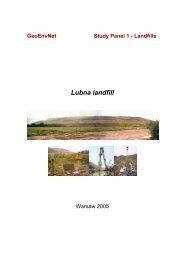ACTA SCIENTIARUM POLONORUM - SGGW
ACTA SCIENTIARUM POLONORUM - SGGW
ACTA SCIENTIARUM POLONORUM - SGGW
You also want an ePaper? Increase the reach of your titles
YUMPU automatically turns print PDFs into web optimized ePapers that Google loves.
76 A. Ptak-Chmielewskabirth rate for this sector. Since 2004 the difference between the birth rate and death ratefor the construction sector has been growing up to 12% in 2008. In 2009 this differencedrops dramatically to 1%. The highest difference and therefore the highest dynamics ofgrowth is observed for the sector “Other services” (ca. 2–4 pp higher than for industryand services). For the industry and services the difference between the birth rate and deathrate becomes negative for 2009. If this tendency prevails the dynamics for these sectorsremains negative and the number of active enterprises decreases. This tendency is veryinconvenient for the economic growth in these sectors.Some very interesting data on small enterprises in Poland was collected by CSO inthe panel survey conducted since 2001 1 . This survey is based on a sample of small enterprises.Basic results of this survey are summarized below (information published by CSOannually after each panel is completed):In 2005 in REGON 211.11 thousand small enterprises (employing fewer than 50 people)were registered (including 208.9 thousand enterprises employing fewer than 10 people).The dominant group consisted of enterprises of private individuals (94.4% of thewhole sample). Only one out of four employers declared that they were going to employnew workers.The most popular form of activity was trade (36.65), real estate and services (18%),construction (11.3%) and industry (9.7%). The most rare activity was business education(1.9%). Majority of new enterprises were completely new units on the market (94.1%).The starting activity was financed with own funds (83.9%), with family and friends funds(6.2%) and bank loans (4.0%).New companies were statistically more often established by men than women (56.8%and 43.2%). The frequency of new companies set up by men was higher than the meanfrequency in construction (87.65), transportation (76.3%), industry (74.4%), real estateand corporate services (61.3%). Women more frequently established new companies inother services (75.6%), education (63.4%), healthcare (62.4%), trade (52,5%) and financialservices (52.3%).1Survey is conducted by CSO (Central Statistical Office) since 2002. Each panel covers enterprisesnewly born in the previous year and observed (re-interviewed annually) during 5 years of theiractivity. In 2007 the 5th panel was completed for the sample of new enterprises born in 2001.Results of each panel are published annually. The newest publications cover data on completedand non-completed panels. All interviews are conducted in autumn of each 5 year period. In thefirst panel newly registered enterprises are interviewed. Starting from the second year only stillactive enterprises are interviewed. No additional observations enter the sample, which contributesto a diminishing amount of enterprises interviewed each year. The survey covers small enterprises(fewer than 50 employees). Survey selection was based on a representative sample covering 3thousand units (1.4% of population) born in 2001. The survey was based on proportional samplingwithout replacement, constant fraction with stratum. Results are presented in basic classifications:legal form, size and type of activity. The questionnaire in subsequent years covered information on:activity, legal form, size, development conditions. In the first year there was extra information onthe way of entering the market and selected owner’s characteristics such as sex, age, education,type of previous employment. Evaluation of enterprise condition used information on the numberof workers, range of activity, financial results, investment and barriers.The completion index was 80–90%. Missing values were imputed by hot-deck method. Weightswere used to assure the adequate stratum assumptions.Acta Sci. Pol.
















